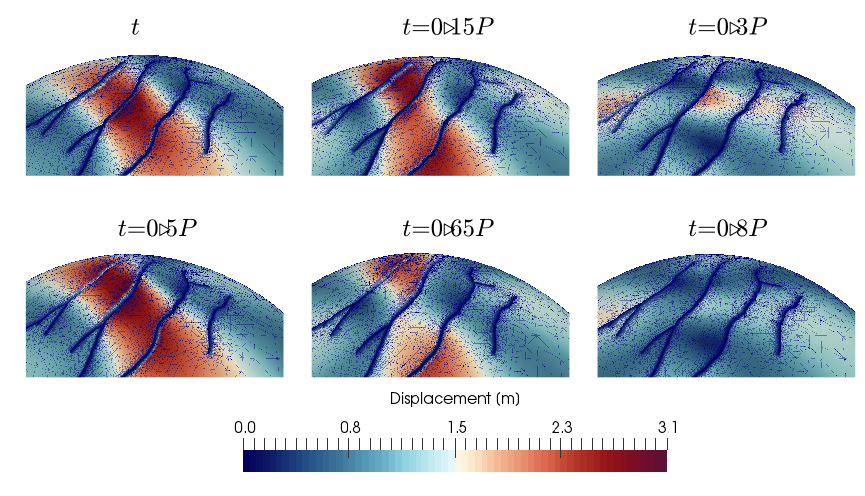Enceladus' tiger stripes as frictional interfaces: Effect on stress and heat production
- 1Mathematical Institute, Faculty of Mathematics and Physics, Charles University, Prague, Czechia (soucek@karel.troja.mff.cuni.cz)
- 2Department of Geophysics, Faculty of Mathematics and Physics, Charles University, Prague, Czechia
Abstract
We propose a new model of Enceladus' tiger stripes in which the ice shell is modeled as an elastic system with frictional interfaces subjected to periodic tidal loading. We find that the diurnal tides produce a complex pattern of stress anomalies, characterized by a length scale of 10 km and the peak values exceeding 100 kPa. Friction slows down the response of the system to tidal loading, leading to an asymmetry between the compression and extension phases. This asymmetry results in additional stress, which is constant in time and comparable in magnitude to the cyclic stress. The static stress field is characterized by compression in the direction perpendicular to the faults and may influence the evolution of the south polar terrain on geological time scales. The total heat flow generated by friction is 0.1-1 GW, accounting for only a small fraction of the heat power emitted from the tiger stripes.
Introduction
In Souček et al. (2016), we have numerically demonstrated a profound effect of faults (tiger stripes) on the tidally induced deformation and stress fields in the south polar region (SPR) of Enceladus. In Běhounková et al. (2017), we showed how this effect can be further enhanced in a synergetic way when combined with a realistic thinning of the ice shell in the SPR for a shell thickness model based on the inversion of gravity and libration data (Čadek et al., 2016). In both these studies, the faults were modeled as zones with significantly reduced elastic moduli. Effectively, this approach corresponds to faults being described as narrow slots partially filled with water (compensating for the overburden pressure within the layer). Such description of the faults is oversimplified since it does not take into account any friction at the faults. We attempt to circumvent this deficiency in the new study.
Model
We solve equations of deformation of a 3D Maxwell visco-elastic planetary shell containing faults in the SPR. The shell's deformation is driven by the incremental tidal potential and at the fault, Coulomb type response is considered. The Coulomb-type friction is mimicked by a continuum model of a fault zone of finite thickness with stress-limiting viscosity. The stress limiter is given by the yield stress, composed of (hydro)static contribution due to overburden pressure and a dynamic contribution due to normal stress variations during the tidal period.
Results

The figure shows periodic variations of the displacement field at the surface obtained for the model with a coefficient of friction 0.2. The displacement is shown for six different phases of the tidal cycle. The symbol P denotes the orbital period. Colors show the magnitude of the displacement while thin blue lines indicate the mesh used in the finite-element solver. The displacement is exaggerated by a factor of 3000 to emphasize the radial motion along the faults. In the talk, we will also address the effect of friction on Enceladus's Tiger stripes on the distribution of stresses in the SPR and on the frictional heating at faults.
Acknowledgments
The research leading to these results received funding from the Czech Science Foundation through project No. 19-10809S. The computations were carried out in IT4Innovations National Supercomputing Center (project no. LM2015070). The study was supported by the Charles University, project GA UK No. 304217, SVV-2019-260447, and SVV 115-09/260581 (K.S.).
References
Běhounková, M., Souček, O., Hron, J.and O. Čadek (2017), Plume activity and tidal deformation of Enceladus influenced by faults and variable ice shell thickness, Astrobiology, 17(9), 941-954, https://doi.org/10.1089/ast.2016.1629.
Čadek, O., Tobie, G., van Hoolst, T., Massé, M., Choblet, G., Lefèvre, A., Mitri, G., Baland, R.-M., Běhounková, M., Bourgeois, O., and Trinh, A. (2016) Enceladus’s internal ocean and ice shellconstrained from Cassini gravity, shape, and libration data. Geophys Res Lett 43:5653–5660.
Souček, O., Hron, J., Běhounková, M., and O. Čadek (2016), Effect of the tiger stripes on the deformation of Saturn's moon Enceladus, Geophysical Research Letters, 43(14), 7417–7423, https://doi.org/10.1002/2016GL069415.
How to cite: Pleiner Sladkova, K., Soucek, O., Behounkova, M., and Cadek, O.: Enceladus' tiger stripes as frictional interfaces: Effect on stress and heat production, European Planetary Science Congress 2021, online, 13–24 Sep 2021, EPSC2021-289, https://doi.org/10.5194/epsc2021-289, 2021.

